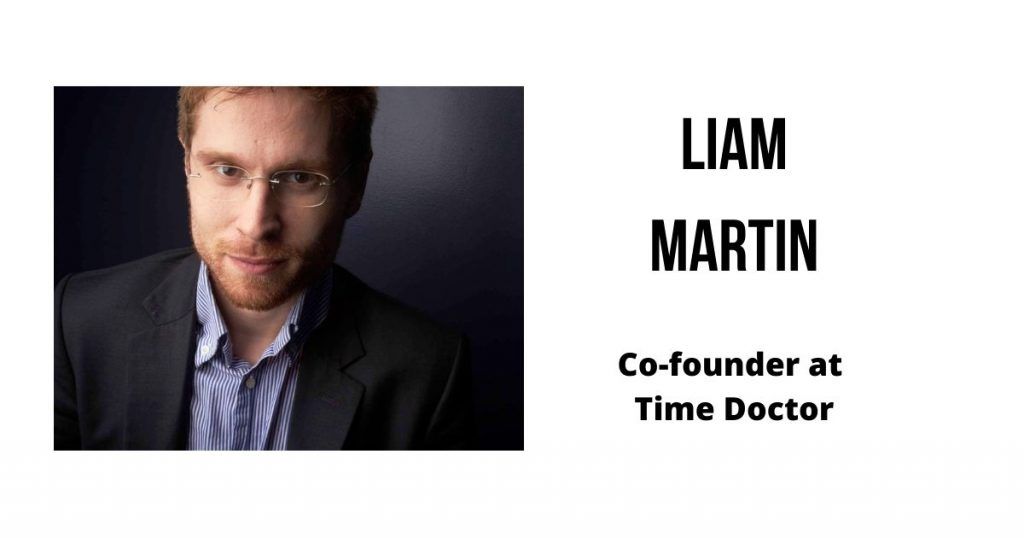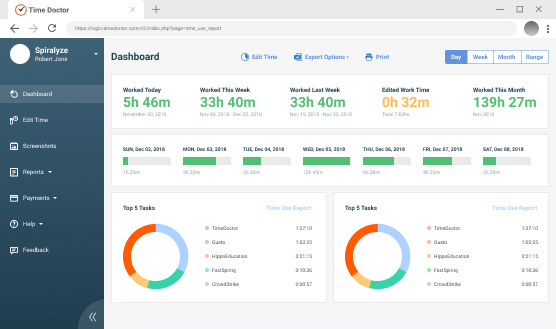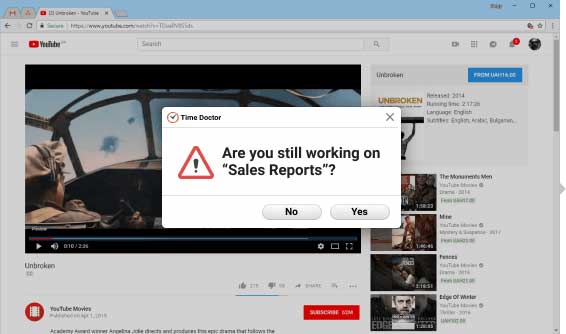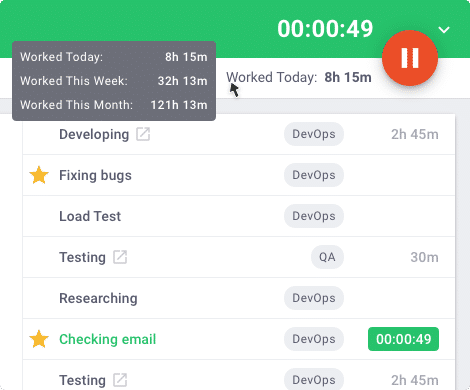The ongoing pandemic has made a lot of software and software categories quite popular. While video conferencing and collaboration software are obvious categories, time tracking software is also important for companies to understand if employees are spending time on the right things while working remotely. Among the most popular software in this space is Time Doctor, a company that was started back in 2012. Its CEO and founder Liam Martin is also behind the Running Remote conference. We managed to catch up with him at the sidelines of SaaS North conference last month. In this wide-ranging conversation, we talk to him about his journey, the evolution of Time Doctor, and what the future of remote working looks like.
PS: the interview has been edited for the sake of brevity.

Table of Contents
1) Before we begin talking about Time Doctor, our readers would love to know your journey into the world of SaaS?
He said “so it started around 2011-2012, between me and my now co-founder, who is the CEO of the company, Rob Rawson. I was speaking at a conference called South by Southwest, a fantastic conference in Austin, Texas about technology and a bunch of other things. And so we met there and he had this crappy little Alpha for a product. It was going to solve one of the core problems that I had in one of my previous business, which was a tutoring business that was remote. So the problem that I had with the tutoring company is that we were managing people through Skype. And we needed to figure out a way to very precisely measure how long a tutor worked with a student that was auditable by the student, and something like this didn’t exist. So I would be getting emails from my students saying that you billed me for 10 hours, when in reality, I only worked with my tutor for five hours. Then I’d have to go to the tutor and say, did you work with the student for 10 hours? And the tutor would say, of course. So then I’d end up having to refund the student for five hours, and also pay the tutor for the full 10 hours. That was destroying the business.”
“So seeing this product it was a lightbulb moment that I had, and realized that this is a big opportunity for me. More importantly, it solves an itch that I’ve had for years. So, I ended up working with him on the project and we both became co-founders,” he added
2) What insights led you to the launch of Time Doctor?
Replying in a straightforward manner, Mr Martin mentioned “a lot of the ways that people classically do market research is bad. Here’s the only way you should do it: find out people who have the same problem as you that are friends of yours. Describe what you’d like to build, and ask them if they think that that’s useful. And if they say yes, ask them how much they would be willing to pre-purchase it right now. And then don’t say anything. If they say yes, you’re in business. 90 percent of the time, they’ll say no. So, a lot of the times people just want to help you out, but very few would actually want to open their wallets. In the case of Time Doctor, I only paid attention to people that were willing to pay me something. And that’s how I did my market research. I basically just got on the phone with a few friends of mine and said would you be willing to pay for this? And we basically pre-sold probably the first couple thousand MRR on the phone itself.“
3) Can you share the evolution of Time Doctor since its inception in 2012?
Continuing the previous reply, he shared “the pre-purchase not only validated the idea, but also funded the initial development along with the capital we both had put in. The company was bootstrapped and we had put in about $50k, which is like a rounding error in today’s day and age. That was in 2012. Fast forward to eight years, and we’ve got 10,000 customers. We’ve got hundreds of thousands of daily users. We’ve got more than 150 people in 47 different countries. We are a remote-first organization by design. So, we don’t have any offices. And quite obviously, with COVID-19 over the last eight months, we’ve seen a significant uptick because we are really specializing in time-tracking for remote work.“

He added “when we look at the market, we’re still notably the first in the time tracking software category. However, we don’t own 50 percent of the market. And for me, market dominance in any type of industry, is what matters. Our business intelligence team has identified 38 different companies that are probably doing more than a hundred thousand ARR. So that’s kind of like when someone does a hundred thousand ARR, they kind of pop up on our radar, and take a look at them and say they are directly competitive to us. Our definition of directly competitive is they would not use both of our products at the same time. As an example, a payroll product is not directly competitive with us, even though we have a payroll feature because they can use both at the same time. So we’re still number one in the space, but we’re not 50 percent. And I actually think that pretty much all industries now we’re starting to see some big moves, and COVID has accelerated in a big way, but whoever ends up becoming the 50 percent owner, will be the leader. I believe, it’ll happen in the next three to five years. I would say pre-COVID, this space was probably worth a billion. Now we’re probably worth about 10 to 15 billion, so it’s a big space.”
4) What’s the current user base of Time Doctor, and what kind of industries are your biggest customers? What are the biggest markets for you?
He told us that “Time Doctor is pretty industry agnostic. I mean, we definitely have a home in the business process outsourcing industry and tech in general, but a lot of agencies use us, but now, after COVID, governments are also using us. Simply put, everyone on planet earth needs this type of technology, if you’re going remote.“
“While the US is still the number one market, I’d say Asia is a close second and actually Europe is a very close third, so we’re pretty evenly distributed everywhere,” he added further.
5) Could you share some insights on how Time Doctor and Staff.com are related, considering the latter was started as something else altogether?
He replied “you’re right Staff.com started as a two-sided marketplace, but today, it’s essentially an enterprise version of Time Doctor. For any company with more than a 1,000 users, Staff.com is for them. In addition, it has the same tech stack, same core backend, but we offer different functionality. It’s really focused on predictive technology. So, predicting as an example, will someone quit their job within the next six months? And we can predict that with about a 96 to 97 percent accuracy rate.“
Upon asking how’re they able to arrive at that conclusion, he shared “we have about 22,000 different variables that the algorithm takes into consideration. For instance, how are your current work trends? And then how do they change over time? And we’re able to identify work trends that resulted in people quitting their jobs.“
6) While time tracking is a useful feature especially for employers, it also borders on employee privacy. How do you balance between both?

Mr Liam Martin answered “I think that’s a classic argument. And I had spoken to some of the early team at Salesforce and they had almost exactly the same problem, which was salespeople refuse to use a CRM because they didn’t want that type of oversight from their boss. But today, everyone would think it’s absolutely ridiculous not to have a CRM. In fact, you can’t do business without it. And I foresee that in the future, probably within the next 10 years, we’ll have an AI assistant to improve your productivity for all sorts of work. I just see that as an endpoint and it’s not necessarily a bad thing. I actually see is a very positive thing that we’re going to be able to work less and get more. We’re going to be more efficient workers. That’s our core mission statement is that we’re trying to make people more productive at Time Doctor. That’s the core tenet of every decision that we make inside of the company. There are some decisions that we need to make to make employers happy, but at our core, we are actually more on the employee side in terms of building features to make them more productive, as opposed to necessarily building features, to monitor what they’re doing.“
7) What’s your go-to marketing strategy to reach out to potential users?
He said “the reality is I think I would have one pre-COVID in one post-COVID answer to this. Initially, we ran a couple of years of doing some really serious SEO work. I’d suggest any bootstrapped founder that’s looking to own the business for more than 10 years that SEO is probably the most profitable method of user acquisition. And it would still be the most profitable form of user acquisition, 10 years into the future. But we also did paid advertising. We do a conference called Running Remote, which is the largest conference on remote work.“
“But fundamentally after COVID, it’s just brand impression. We’re at a point now where the entire world is now working remotely. 60 percent of everyone that works on a computer is now working remotely on planet earth. And it was about 5 percent before that, and that’s not going to change even after the vaccine is discovered and we have herd immunity. I’d estimate probably still about 50 percent of all computer workers will continue to work remotely because the unit economics of it are just undeniable and employers have discovered now that they’re getting the same levels of productivity from their workers, while they don’t have to pay for an office. Since the largest line item on a P&L outside of staff is your office, so remote work is here to stay. And the question is are we going to be part of that remote work stack? We know there’s going to be a time tracking solution inside of the remote work stack, and we just want it to be us. So far, it’s us, but we just want to continue on with that.“
8) How has the growth been like for Time Doctor amidst the ongoing pandemic?
“I’d say that we’ve grown more in one quarter than we did all last year. And in the next quarter, we grew more than all previous quarters of 2020, plus the last year. We’re still continuing on with that trend. As I had mentioned earlier, remote work is here to stay. I’d probably say that the space went conservatively 10X and quite possibly 20X during this time,” he commented.
Related read: 45 remote work statistics that you should know about the future of working from home
9) Speaking of that, you have also co-founded Running Remote conference. What led you to the launch of the same?
He shared that “there was no conference on remote work. At least the ones that I wanted to see before that point. We’ve been running it for about three years and there’s lots of conferences on how to get a virtual assistant or how to be a digital nomad, but there were very few conferences on building and scaling billion-dollar remote-first organizations, and that was exactly what we wanted to learn about. So we couldn’t find it anywhere in the community, so we just decided to build it. And it’s honestly, my dessert business. I don’t really care whether we make any money off of it. I’m really just more interested in learning about how to build and scale remote teams, more efficiently.“
10) How do you think the pandemic will shape up the future of remote work?
Mr Martin stated that “Time Doctor is going to replace the entire time tracking industry. If you actually look at the classic time-tracking industry, it does about $40 billion a year. And the classic time-tracking industry is a little box that you put in every office, or you have some type of thumbprints when you go in and out. That industry will probably be a third of the size in the next five years, it’s going to heavily contract because no one’s going to be in offices anymore. I fully expect by this time, next year, there will be probably a net drop of 25 percent of office leases in the United States. Because of that, you’ll have tools like time doctor, which are going to replace the time tracking.“

Adding further, he shared “take Zoom for instance, they just replaced all the airlines. Every single business ticket for all business travel is going to be on Zoom. So before I used to pay $3,000 for a business class ticket from New York to Los Angeles, and now that has turned into a $10 a month subscription. The beauty of it is we always knew that this was going to make sense, but it required COVID to force everyone to test this assumption for six months. More importantly, everyone has now recognized that deal flow is exactly the same, and business development is exactly the same. There are no differences. Everyone is still doing business at the same level. This means that remote work will become a norm rather than an exception.“
11) What does the future roadmap look like for Time Doctor, Staff.com and Running Remote conference?
He mentioned “I think that the real thing that everyone is trying to measure is are you doing the right things to accomplish the tasks that you need to accomplish? And you don’t need to micromanage someone to do that, because micromanaging is basically a really cost-inefficient expenditure of someone’s time. When you could have a tool that someone could work with internally to be able to truly figure out where their problems are in their workday and their own personal productivity, and then how to optimize for them. So that’s basically what we’re building. I think that the entire concept of tracking time will actually become a very small part of the future of the current industry that we’re in.“
12) What are your favourite SaaS products out there?
He told that “when you asked that, the first one that jumped to mind for me was ChartMogul. It’s so critical to all of our business operations inside of Time Doctor, we just run absolutely everything from it.“






